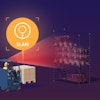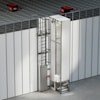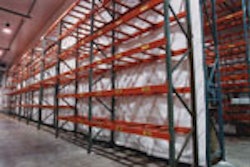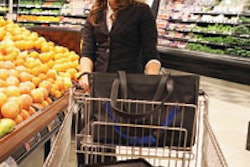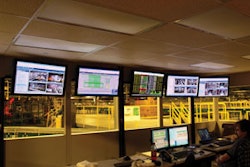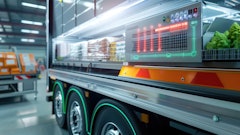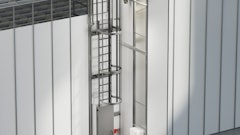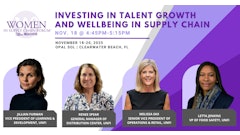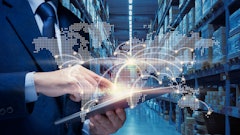
Sustainability is in the lexicon of just about everyone today. Whether that means turning off an unused lamp at home, driving a hybrid car, or operating a LEED-certified warehouse using energy-efficient equipment, people are looking for ways to reduce their resource consumption in an effort to save money while reducing their carbon footprint.
But what exactly does sustainability mean as it relates to the industry's warehouses and DCs? These facilities are energy-driven hubs operating assets like forklifts, conveyor systems, HVAC, refrigeration and overhead lighting.
Energy reduction helps companies achieve impressive bottom lines and, in the broader perspective, it assures tomorrow's generations the energy they will need to sustain economies and qualities of life. As Rod Ellsworth notes: "I define global asset sustainability as the management of property, plants and equipment to meet the operations, economic and socio-economic needs of today without compromising the ability of future generations to meet their own such needs."
Ellsworth is vice president of business consulting solutions for enterprise asset management at Infor Global Solutions in Alpharetta, GA.
The sustainability story begins with the design of a LEED certified building. Once the building is constructed, the next challenge is maintaining the optimal energy-efficient operation of assets within the box.
Energy Efficient By Design
Although companies can retrofit their existing warehouses and DCs to achieve LEED (Leadership in Energy and Environmental Design) certification, most LEED certified food and beverage warehouses and DCs are new construction, notes Jayme Wu, design project manager for Jacksonville, FL-based Stellar.
Upfront costs for designing and constructing a green building are higher compared to conventional buildings, but those costs are mitigated in a matter of years through reduced operating costs.
Companies can aim for one of four LEED certification levels: Certified, Silver, Gold or Platinum. "At the design phase, companies determine what level is reasonable for them to attempt, because trying to earn some points can get very costly," notes Rex Smith, senior design project manager for Stellar.
Companies achieve a particular level after accruing a specified number of credits in six categories: sustainable sites, water efficiency, energy and atmosphere, materials and resources, indoor environmental quality and innovation and design.
• Sustainable sites: "Since warehouses usually have an office associated with the facility, you can get credit if you build close to public transportation so employees can get to work," explains Smith. In addition, providing parking areas for fuel-efficient vehicles will assist in earning more credits.
• Water efficiency: Choose plumbing fixtures requiring low-water usage such as waterless urinals and low-flow fixtures.
• Energy and atmosphere: Design the HVAC system to optimize energy performance. "Some of this has to do with the building envelope," explains Smith. "For instance, using more insulation in the walls will make the building more efficient."
• Materials and resources: Use building materials such as white TPO (ThermoPlastic Olefin), which doesn't create a heat island caused by dark roofs and asphalt parking lots. Using concrete rather than asphalt for parking lots will assist in earning credit.
"Most of these types of buildings are constructed with insulated metal panels, especially in freezer applications," Smith says. The wall system is solid insulation with metal skin on both sides, offering a high degree of insulation. Reusing and recycling building materials-or using products made from recycled content-will assist in earning points. So will buying products manufactured within 500 miles of your site or using only certified wood grown in a certified forest.
• Indoor environmental quality: Control the environmental quality during construction. Use adhesives, sealants, paints and carpets manufactured with low-emitting VOCs (Volatile Organic Compounds) to control the indoor environmental quality.
• Innovation and design: Earn additional credit for suggesting a new idea or for earning points exceeding the required benchmarks in specific categories.
Energy Mitigation
The commitment to build a LEED-certified building doesn't end once the building is completed. Sustainable responsibility continues. "We help companies operate and maintain their facilities to their specific design-performance levels," says Ellsworth at Infor. "Our continuous commissioning process, built into our software application, ensures the facility and its assets operate at optimal energy efficiency."
Ellsworth talked to over 120 companies around the world in the last year to discover concerns and initiatives in this arena. "Since energy is the single largest operating and maintenance cost, comprising 60 percent to 70 percent of a company's cost structure, these companies want to mitigate their energy consumption."
Infor helps companies maintain optimal energy performance of everything within the four walls of the facility by monitoring every energy-consuming asset. "We make sure they meet their production and throughput requirements for the least energy cost," Ellsworth explains. In fact, benchmarks have been established by the Department of Energy, Texas A&M University and others that report companies can expect to reduce energy consumption by six percent to 20 percent per monitored asset.
Every asset's energy consumption is metered. Infor's software applications factor in energy efficiencies of every system, maintaining the systems accordingly. "Understanding the actual energy consumption, we know the associated carbon emissions related to generating a kilowatt hour of energy to run a motor, for instance," explains Ellsworth.
Knowing how a motor was designed to run and what its peak operating performance is helps control its energy consumption. "If it starts consuming more energy than it was designed to consume, we automatically send out an alert or work order for the maintenance technician to fix the problem and bring it back into design spec," explains Ellsworth.
Infor also helps facilitate the replacement of equipment if more energy-efficient alternatives are available. "For example, knowing how much energy each individual motor is consuming on a conveyor line helps us determine if assets could be replaced in order to reduce a company's carbon emissions."
Ellsworth reports an ROI of three or four months is about average, after which the initial software cost pays for itself. He adds that companies might expect to save over 20 percent of their energy costs.
The Business Perspective
Lawson Software's entry into sustainability is a response to its customers' interest, which led the company to co-sponsor a study by AMR Research of manufacturing and services companies in the U.S. and Western Europe. They found that the leading sustainability initiatives were reduced energy consumption, emissions, water consumption, and solid waste.
"What we do is capture how much of these resources are being consumed in the facility," explains Jeff Frank, vice president of marketing and CSR (compliance and sustainability-related) guru at the St. Paul, MN-based company. The information enters Lawson's ERP software via the manufacturing process or through interfaces from metering systems provided by a third party.
Prior to the availability of these kinds of software programs, there was no way for decision-makers to have information they needed to make strategic business decisions to drive down costs, improve profitability, or reduce environmental impact, notes Frank. "Having this information in real time allows managers to see what their actual results are and if they are tracking to their targets."
Beyond managing and monitoring processes to assure optimal efficiencies, companies are also measuring. "Successful companies set goals for what they want to accomplish and they measure their progress over the course of time because you can't manage what you don't measure," notes Frank.
In addition to these best practices, Frank says the next level of sustainability will be designing products and manufacturing processes in line with environmentally friendly initiatives to reduce resources consumption.
Another area gaining interest is tracking and tracing as it relates to global sustainability, adds Frank. For instance, visibility throughout a company's global supply chain can inform stockholders, retail customers and consumers who are the countries of origin supplying raw materials.
"Companies can then advise if those countries are impacting their environments in a responsible manner as they produce food. We think this will become a powerful marketing tool so retailers can provide this kind of information to their consumers, thereby building buyer confidence," says Frank.
Beyond the economic benefits derived from sustainable business practices, companies can achieve a positive public relations image. But the most successful sustainability initiatives need support from the top down, says Frank. "The best practices we see implemented are predominately in companies with executive buy-in. If you don't have support from senior executives, the chances are not great that these types of sustainability initiatives will proceed over the long-term."
In the broader view, it will cost companies not to be green. Not only will they be at a competitive disadvantage in the marketplace, says Ellsworth, but it will cost companies not to be energy efficient. "Legislation is considering a plan that could have companies paying a tax or buying carbon credits if they are over certain emissions thresholds."
A pending greenhouse emissions bill could require a 65 percent reduction of carbon emissions by 2050.
Incorporate Reverse Logistics Into Your Sustainability Goals
By Mark Doughton

The book titled Green to Gold by Daniel C. Esty and Andrew S. Winston devoted much discussion to the upstream and downstream components of a corporate sustainability program.
However, one key component wasn't mentioned: the backstream, or reverse logistics program. While it is tempting to put a sustainability program in place and never look "back," that approach simply is not a sustainable long-term option.
And, here's why...an overall corporate sustainability program includes people, planet and profits. Unsaleables/returns impact all three. Consider the following ways that incorporating a reverse logistics facility can assist with achieving your organization's sustainability goals.
1. Eliminate/alleviate landfill costs and potential fines by shipping returned product to a returns center for value-added disposition: recycling, liquidation and donation. For example, in just one year for one client location, a recycling program designed to utilize dry unsaleable product for livestock feed eliminated 17 landfill hauls and reduced landfill usage by 177 tons.
2. Reduce carbon footprint by shipping to regional distribution returns centers rather than one central location.
3. Leverage the scale and volume of a returns center to maximize recovery on secondary sales through cross merchandising programs. A drug store chain began an asset recovery project 12 months ago that eliminated three million unsaleable products from the landfill and in turn increased its liquidation revenue by over 200 percent from the previous year.
4. Utilize value-added services such as repacking and refurbishing to return product to stock, prepare goods for donation or recoup value on the secondary market.
5. Delegate the recycling of secondary packaging to a returns center as part of its overall program (for example, cardboard, plastic shrink wrap, paper, plastic bottles and plastic bags).
6. Collect important data on returned product to understand root cause and to develop returns prevention programs that lead to improved profits. A collaborative study conducted with a manufacturer and retailer uncovered a package design flaw that resulted in a high rate of returns.
A $150,000 package redesign by the manufacturer resulted in an estimated savings of over $2 million for the manufacturer's retailers through reduced labor costs and product shrink.
7. Monitor the impact of sustainable packaging changes on damages and returns by collecting data at the returns center.
8. Make the most of product that must be incinerated by participating in returns center programs for converting waste to energy. Through such a program a large manufacturer now recycles 93 percent of its hazardous products that are flammable solids or liquids.
9. Protect the consumer during a recall by quickly and efficiently returning product to a returns center for quarantine, evaluation and proper disposal. During a recent recall, more than 2.5 million items were processed and properly disposed of, according to lot and date code, through witnessed incineration, thus ensuring full compliance with government regulations.
10. Incorporate a "back stream" component to your up- and downstream sustainability program for a holistic sustainable supply chain approach.
Doughton is president of CLS (Carolina Logistics Services), a reverse logistics and supply chain solution provider based in Winston-Salem, NC.



